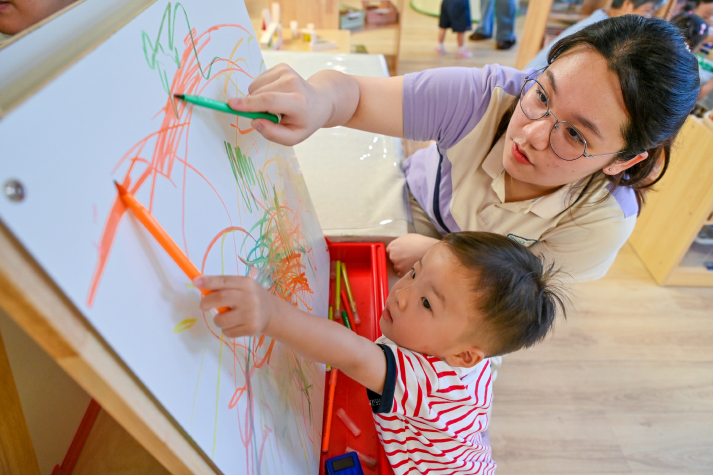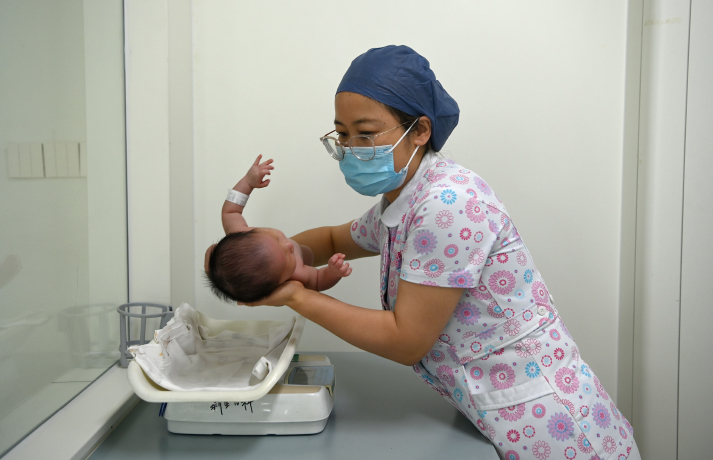| China |
| What a birth rebound means for China's demographic challenges | |
|
|
 A teacher guides a child in drawing at a childcare center for children under 3 in Nanjing, Jiangsu Province, on September 4 (XINHUA)
Recent reports from multiple regions in China indicate increases in the number of births in the first half of 2024, compared with the same period in 2023, a noteworthy development following two consecutive years of negative population growth in 2022 and 2023.
In Guangdong Province, for example, the number of births rose by 1.4 percent year on year during the first six months of the year, as announced by Liu Fenghua, deputy head of Guangdong Women and Children Hospital, in July. In Shandong Province, Qingdao recorded 22,669 births in the first half of the year, a year-on-year increase of 5.93 percent, according to local health authorities.  A nurse weighs a newborn at a hospital in Xi'an, Shaanxi Province, on June 1 (XINHUA)
A temporary uptick Experts partially attribute this uptrend to the cultural preference for having children in the Year of the Dragon—considered auspicious in Chinese astrology. Several demographers also attribute the slight rebound in births to some couples waiting to have children until after the COVID-19 pandemic due to health concerns. Yuan Xin, Vice President of the Chinese Population Association, noted that China's fertility rate showed a downward trend during the pandemic. A slight rebound often follows a serious epidemic or pandemic, although the extent of this rebound remains unpredictable. He also highlighted an increase in marriage registrations in 2023, which reached 7.6821 million—a 12.4-percent year-on-year increase. Given the common practice in China of having children one to two years after marriage, this trend could result in a corresponding increase in births in 2024. The implementation of supportive birth policies at the local level is also cited as a reason for the rising births. These policies include extended maternity and paternity leave, increased financial subsidies, and enhanced childcare services and medical insurance, creating a more birth-friendly environment. "In the short term, robust fertility subsidy policies are effective," explained Yang Fan, associate dean of the School of Population and Health at Renmin University of China (RUC), in an interview with the financial news magazine Yicai. China has adjusted its family-planning policy multiple times in recent years, allowing all couples to have two children since 2016 and three children since May 2021. "The policy encouraging three children has not led to a rebound in the birth rate. This is primarily because the previously suppressed demand for second children has already been met through the earlier two-child policy. The inclination and demand for a third child remain low. Consequently, the impact of relaxing family-planning policy on childbearing decisions is diminishing," Yuan explained. He said that focusing solely on policies that relax childbirth restrictions will likely yield diminishing returns. Commenting on the birth rebound, Song Jian, a professor at the School of Population and Health at RUC, told Yicai magazine that while the current rebound is encouraging, it is localized, partial, and may be short-lived. "A cautiously optimistic attitude is warranted," she advised. She further pointed out that international experiences demonstrate that in the early stages of a country's negative population growth, the total population typically fluctuates around the "zero-growth range." Whether China will record positive population growth this year remains uncertain. "The decline in the number of women of childbearing age is an established reality, and the trends of declining birth rates and negative population growth will likely persist," she said. Yuan echoed this sentiment, asserting that the long-term trend of negative population growth is unlikely to be reversed by temporary fluctuations.  Senior residents pick up meals at a community canteen in Jiaxing, Zhejiang Province, on August 20. (XINHUA)
Challenges ahead China's current population structure faces significant challenges, with low fertility rates and moderate aging intertwined. Statistics from the Ministry of Civil Affairs reveal that the number of senior citizens aged 65 and above reached 217 million last year, accounting for 15.4 percent of the total population, categorizing China as a moderately aging society. According to international standards, a society is considered moderately aging when 20-30 percent of the population is aged 60 and above or when 14-20 percent are aged 65 and above. The old-age dependency ratio stands at 22.5 percent, meaning there is one elderly person to support for every 4.4 persons of working age. The old-age dependency ratio is determined by the number of individuals aged 65 or older per 100 persons of working age (ages 20 to 64). According to Yang, the decrease in fertility rate is the root cause of both negative population growth and the aging population. Yang believes two main factors drive the continuous decline in fertility rate: decreasing number of women of childbearing age and delayed childbearing. Chen Wei, a professor of demography at RUC's Population Development Studies Center, said earlier this year that from 2017 to 2022, the number of women of childbearing age (ages 15-49) in China decreased by an average of 5 million annually. In Song's view, while the reduction in the number of women of childbearing age is a confirmed trend, the decline in births resulting from delayed childbearing could potentially be mitigated through effective birth support policies. By developing a robust system of birth support policies, the challenges faced by individuals of childbearing age who "want to have children but are apprehensive" can be alleviated. Government incentives At the national level, the State Council, the highest state administrative organ, unveiled 13 targeted measures in October aimed at enhancing childbirth support services, expanding childcare systems, and promoting a birth-friendly social atmosphere. A childbirth subsidy system will be established, with pledges to increase related personal income tax relief. New parents can now feel more confident taking time off work, as local authorities are urged to ensure the implementation of maternity, paternity, and childcare leave policies. To improve access to childcare services, childcare service centers will be established at the prefecture and city levels. Childcare facilities will also be planned, constructed, and approved in step with the establishment of new communities. At the local level, multiple regions have begun to implement measures to support childbirth, including financial assistance and service enhancement. According to the National Health Commission (NHC), 23 provinces across the country have adopted childbirth subsidy systems. For example, beginning on January 1, 2023 and ending on December 31, 2025, the Yunnan Provincial Government is offering families giving birth to a second child a one-time subsidy of 2,000 yuan ($276) and those having a third child a one-time subsidy of 5,000 yuan ($689). Additionally, families with a second or third child receive an annual childcare subsidy of 800 yuan ($110) until the child reaches the age of 3. A significant barrier to increased childbirth is the lack of care for infants and toddlers aged 0 to 3. In response, last year, the NHC and the National Development and Reform Commission designated 33 cities as national demonstration cities for infant and toddler care services, introducing related policies to support and encourage the development of these services. Nanjing City in Jiangsu Province is among these 33 demonstration cities and is encouraging private sector involvement in childcare services for children under 3 through measures including financial subsidies, rent reductions, and tax incentives. Wang Jing, Deputy Director of the Nanjing Municipal Health Commission, noted in a July interview with China Central Television that parents in the city are able to send their children to childcare centers immediately after maternity leave ends. She said that options including full-day care, temporary care, half-day care, and hourly care help parents balance their childcare responsibilities with work commitments. In terms of time support, maternity leave in all provincial regions has been extended to over 158 days, as reported by the NHC. Targeted approach Song said continuous optimization and improvements to birth support policies are crucial. She said, "To effectively address demographic challenges, optimizing fertility support policies requires aligning population needs with policy offerings as closely as possible." She explained that individuals of childbearing age can be categorized into different groups: unmarried, married but childless, married with one child, and married with two children, with each group having distinct needs. "If fertility support policies treat individuals of childbearing age as a homogeneous group, there may be a disconnect between policy provisions and actual needs," she cautioned. Yang also emphasized that birth support policies should aim to alleviate the economic burdens on families and the challenges of childcare, with the ultimate goal of enhancing overall public happiness. "As happiness increases, the willingness to have children will naturally rise," she noted. Another often-overlooked factor influencing birth rates is the macroeconomic situation. "When the macroeconomic outlook is positive and the public has optimistic expectations concerning job stability and future income, it can also contribute to an increase in the birth rate," Zhou Haiwang, Deputy Director of the Institute of Urban and Demographic Studies at Shanghai Academy of Social Sciences, told Yicai magazine. Hence, targeted policies taking into consideration various socio-economic factors will be essential for achieving sustainable population growth in the long term. (Print Edition Title: A Positive Signal?) Copyedited by G.P. Wilson Comments to jijing@cicgamericas.com |
|
||||||||||||||||||||||||||||
|